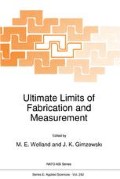Abstract
Admittance Spectroscopy is a very powerful technique for determining dielectrical properties of a given material. It can be applied in a variety of different scientific fields and the material under study may be a solid or a liquid. The technique has not only been used for measuring fundamental properties but also for monitoring purposes, e.g. electrolytical processes in batteries [1], fouling phenomena of proteins [2], thin film growth [3] and for biosensor applications [4–6].
Access this chapter
Tax calculation will be finalised at checkout
Purchases are for personal use only
Preview
Unable to display preview. Download preview PDF.
References
Hooper, A. (1985)AC measurement and analysis techniques in C. A. C. Sequeira and A. Hooper (eds), Solid State Batteries, Martin Nijhoff Publishers, Dortrecht, pp. 261–268
Nordman Montelius, M (1988) Some Studies of Fouling Phenomena on Non-Heated Food Contact Surfaces, Doctoral Dissertation, Lund University, CODEN: LUTKDH/(TKLT-1010)
Zhou G.-G., Kowel S. T. and Srinavasan M. P. (1988) A Capacitance Sensor for On-line Monitoring of Ultrathin Polymeric Film Growth, IEEE Trans. Compon. Hybrids, Manuf. Technol., 11, 184–190
Bilitewski, U., Drewes W. and Schmid R. D. (1992) Thick film biosensors for Urea, Sensors and Actuators, B7, 321–326
Pethig R. (1991) Dielectric Biosensors, Biochem. Soc. Trans., 19, 21–25 (and refrences cited therein)
de Vries P. M. J. M., Langendijk J. W. G., Kouw P. M., Visser V. and Scneider H. (1993) Implications of the behaviour of human blood for continuous online measurement of haematocrit, Med. Biol. Eng. Comp., 31, 445–448
Gallati H. (1977) Enzym-Immunologische Tests: Aktivitätsbestimmung von Peroxidase mit hilfe des “Trinder-Reagens”, J. Chem. Clin. Biochem., 15, 699–703
Westerhoff H. V., Astumian R. D. and Kell D. B. (1988) Mechanisms for the interaction between nonstationary electric fields and biological systems: II Nonlinear dielectric theory and its limitations, Ferroelectrics, 86, 79–101
Ling T. G. I., Tegenfeldtd J. O. and Montelius L. (1994) Nanometer sized electrodes in admittance spectroscopy for biological molecules, Submitted to Sensors and Actuators
Author information
Authors and Affiliations
Editor information
Editors and Affiliations
Rights and permissions
Copyright information
© 1995 Springer Science+Business Media Dordrecht
About this chapter
Cite this chapter
Montelius, L., Tegenfeldt, J.O., Ling, T.G.I. (1995). A Nanosensor for Admittance Spectroscopy. In: Welland, M.E., Gimzewski, J.K. (eds) Ultimate Limits of Fabrication and Measurement. NATO ASI Series, vol 292. Springer, Dordrecht. https://doi.org/10.1007/978-94-011-0041-0_15
Download citation
DOI: https://doi.org/10.1007/978-94-011-0041-0_15
Publisher Name: Springer, Dordrecht
Print ISBN: 978-94-010-4023-5
Online ISBN: 978-94-011-0041-0
eBook Packages: Springer Book Archive

